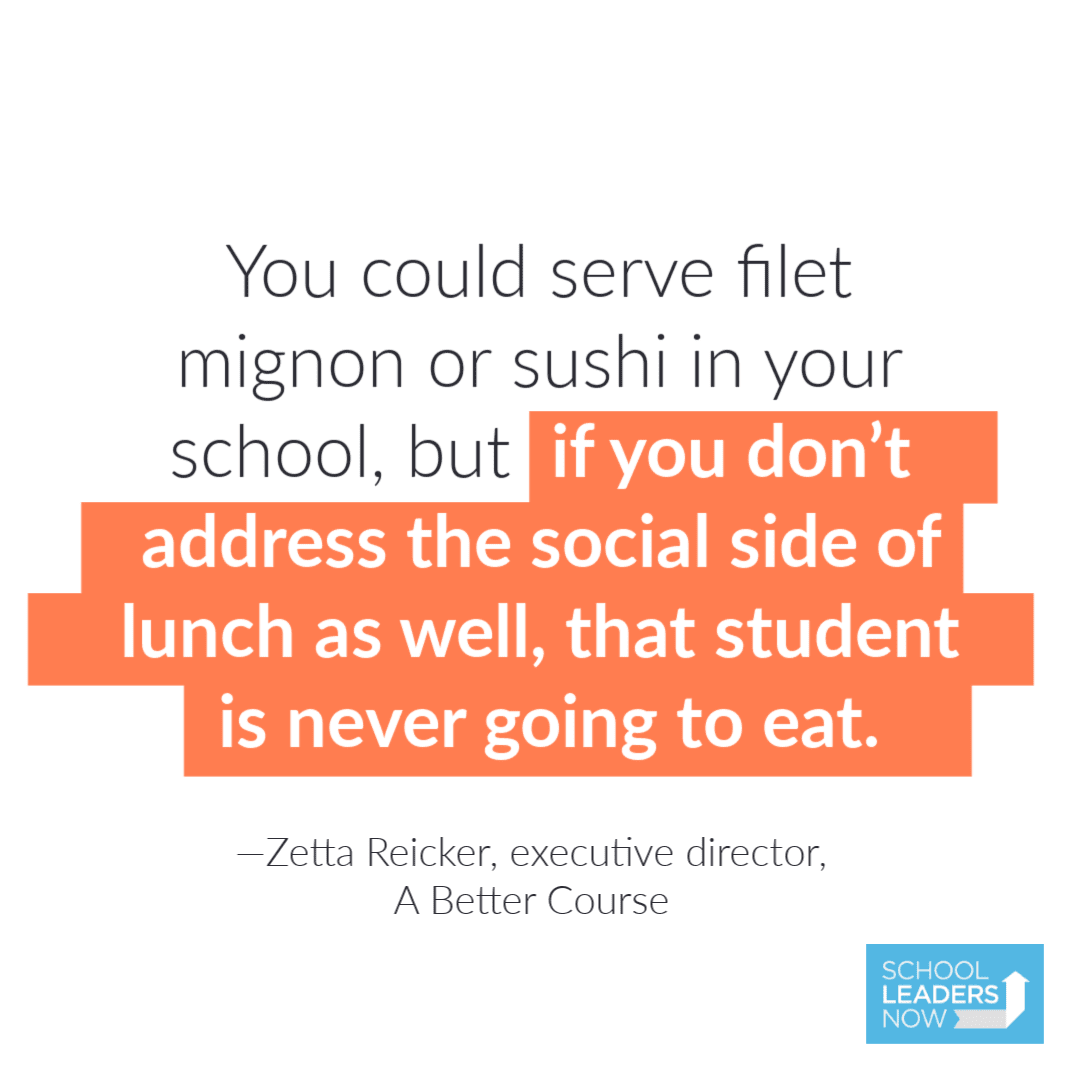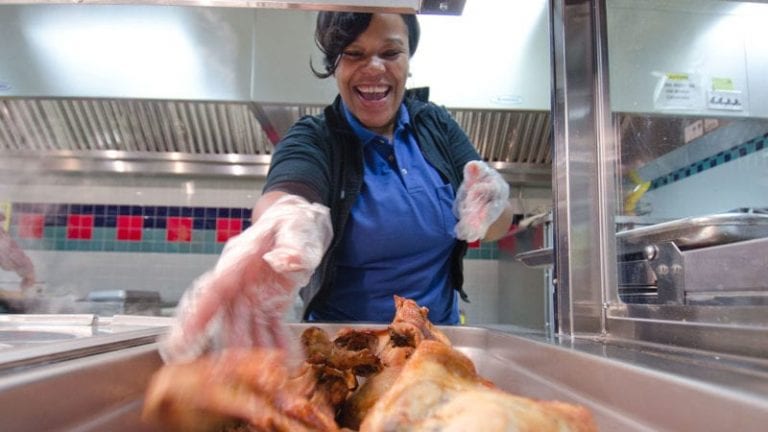You’ve devoted a lot of time to selecting and implementing a developmentally appropriate math curriculum. How much time have you spent pondering your students’ lunch experience?
If you’re like most administrators, the answer is not much beyond figuring out the logistics of feeding hundreds of students between the all-important academic classes. In many schools, cafeterias are still institutional spaces that contain large tables and long lines. Social hierarchies are readily apparent, and student behavior sometimes spirals out of control, demanding disciplinary attention.
There’s a better way to do school lunch.
Zetta Reicker, executive director of A Better Course, is on a mission to improve the school lunch experience. Meeting students’ nutritional needs is part of the equation, but lunch, she says, is so much more than bodily sustenance. It’s a chance to affect students’ physical and emotional well-being, to support developing independence, and to develop meaningful relationships.
“I encourage superintendents to really look at school food as an opportunity to enhance your school culture, enhance the health and wellness of students, and ensure that students feel included,” says Reicker, who previously served as the nutrition director of the San Francisco Unified School District. “Sharing food is a real opportunity to bring students and staff together.”
What are the challenges and opportunities with managing school lunch programs?
Currently, most school lunch programs are designed around the needs of adults. Logistics and convenience (for nutrition workers and educators) shape the lunch experience. The system, however, doesn’t work particularly well for students.
Consider a ninth grade girl from a low-income home. She qualifies for free lunch, but her four best friends routinely bring lunch from home and aren’t interested in walking to the other side of campus with her so she can stand in line. She doesn’t want to ask, either; time with her friends is far more important to her than a mediocre school meal anyway, and the last thing she wants to do is draw attention to her financial status.
“Most likely, that child is just going to go without or snack off her friends’ lunch,” Reicker says. “You could serve filet mignon or sushi in your school, but if you don’t address the social side of lunch as well, that student is never going to eat.”

Getting kids to eat lunch means changing the paradigm.
Hungry students don’t learn as efficiently. “You can have the best designed curriculum and the most capable teachers, but if the children sitting in the classroom don’t have the right nutrients to nourish their brains and body, they’re not going to absorb information well or participate fully in the classroom,” Reicker says.
Rethinking the lunch experience is also an opportunity to support students’ socioemotional needs. “Many districts are now starting to embrace a whole child approach; they’re recognizing that social-emotional development is as important as English, math, and science,” Reicker says. “School food can absolutely be a core piece of that.”
In fact, in many middle and high schools, lunchtime is currently a time “when things go downhill behaviorally,” she says. “That’s when arguments happen. It’s where cliques are a problem. Many school counselors will tell you that their busiest time is after lunch. If you don’t have positive interaction at lunch, it can really have a negative impact on the school environment.”
Deliberately considering students’ needs can lead to a much healthier environment. Factor in development. Lunch at many high schools still looks a lot like lunch at the local elementary school, and that doesn’t make sense. “Academics change as children evolve developmentally; why doesn’t lunch?” Reicker says. The social and developmental needs of teenagers are much different than those of elementary students; creating a lunch experience that recognizes and supports their development will enhance growth.
Moving toward a student-centered lunch experience.
It’s not easy to overhaul school lunch, but it’s well worth your effort. Reicker advises taking these steps to get started:
1. Start with nutrition services.
Your nutrition services director and food-service staff may already have some good ideas about how to improve the lunch experience. Schedule a meeting (or informal listening session) to discuss their observations and ideas. It’s also time to fully incorporate the food services department into the overall operation of the school. If food services currently operates in a silo—separate from instructional services and administration— “include them in meetings where you’re discussing lunch scheduling or working on design changes due to a bond renovation,” Reicker says.
2. Involve students.
Student involvement is key. A FoodCorps survey of more than 300 students across nine different communities revealed that “students want their voices to be heard … they value the break from academic learning that lunchtime provides, and they want a cafeteria experience that provides choices and reflects their cultural identity.”
Eating and talking with students over lunch can provide some valuable insights, but consider formal surveys and brainstorming workshops as well. Tap into the expertise of your educators; they have tons of experience working with students.
3. Build infrastructure.
Go slow. Successful, sustainable change requires significant infrastructure; if you try to move forward without first building appropriate systems of support, your efforts will likely fail. Once you’ve identified student needs and desires, map out a plan. List goals, necessary changes, and available equipment and resources. Consider staffing, procurement, and technology.
“All of this sounds really snooze worthy, but without those pieces of infrastructure in place, you can’t build a sustainable program,” Reicker says.
How are you rethinking school lunch? Share with us in our Principal Life Facebook group.
Plus, Enough With Donuts With Dads and Muffins With Moms—Let’s Make All School Events Inclusive

